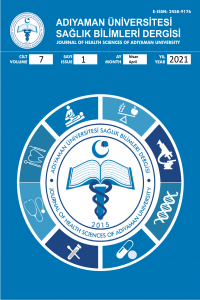Çocuk Acil Servisine Başvuran Trakeostomi nedeniyle Teknoloji Bağımlı Hale Gelen Çocukların Değerlendirilmesi
Çocuk, acil, trakeostomi
Evaluation Of Children Admitted To Emergency Department Who Require Special Care
Pediatric emergency, tracheostomy, technology,
___
- 1. Spratling R. Defining Technology Dependence in Children and Adolescents. West J Nurs Res 2015; 37(5): 634-51.
- 2. Glendining C, Kirk S, Guiffrida A, Lawton D. Tecnology dependent children in the comminity: Definitions, numbers and costs. Child Care Health Dev 2001;27:321-34.
- 3. Beale H. Respite care for technology-dependent children and their families. Paediatr Nurs 2002 Sep;14(7):18-9.
- 4. Shimizu F, Suzuki M. Role development of nurses for technology-dependent children attending mainstream schools in Japan. J Spec Pediatr Nurs 2015 Apr;20(2):87-97.
- 5. Didişen NA, Özdemir HNÇ, Keskin E. Technology Depends Children and Home Care. Journal of Pediatric Emergency Intensive Care Med 2017; 4(3): 123-129
- 6. Hsia SH, Lin JJ, Huang IA, Wu CT. Outcome of long-term mechanical ventilation support in children. Pediatr Neonatol 2012;53(5):304-8.
- 7. Lawrason A, Kavanagh K. Pediatric tracheotomy: are the indications changing? Int J Pediatr Otorhinolaryngol 2013 ;77(6):922-5.
- 8. Dogan M, Uysal İÖ, Yüce S, Güven AS , Polat K, Arpacık M, Can F Pediatrik Trakeostomi: 25 VAKANIN Endikasyon ve Komplikasyon Analizi. Bozok Med J 2015;5(4):17-21
- 9. Düzkaya DS, BozkurT G, Yakut T. Yoğun Bakımdan Taburcu Olan Tıbbi Teknolojiye Bağımlı Çocuklara Verilen Evde Bakım Hizmetlerinin Değerlendirilmesi. Journal of Health Science and Profession 2017; 4 (3):204-211
- 10. Berry JG, Graham DA, Graham RJ, Zhou J, Putney HL, O'Brien JE, Roberson DW, Goldmann DA. Predictors of clinical outcomes and hospital resource use of children after tracheotomy. Pediatrics 2009 Aug;124(2):563-72.
- 11. Doğan R, Başaran B, Pınar H U, Arslan M. To eveluate the clinical outcome in patients discharged for home care with traceostomy. Journal of the Turkish Society of Intensive Care 2011;9:99-102
- 12. Koçkar T, Ünal F, Şahin Ş, Ondalıkoğlu G, ÖktemS. Trakeostomili Çocuklarda Takip Sonuçlarımız. Zeynep Kamil Tıp Bülteni 2018;(49)3: 290 – 293
- 13. Agarwal A, Marks N, Wessel V, Willis D, Bai S, Tang X, Ward WL, Schellhase DE, Carroll JL. Improving knowledge, technical skills, and confidence among pediatric health care providers in the management of chronic tracheostomy using a simulation model. Pediatr Pulmonol 2016;51(7):696-704.
- Yayın Aralığı: Yılda 3 Sayı
- Başlangıç: 2015
- Yayıncı: ADIYAMAN ÜNİVERSİTESİ
İliak arter girişimi için transpedal yaklaşım: Nadir bir olgu sunumu
1997-2016 Yılları Arasında Eskişehir’deki Ateşli Silaha Bağlı Ölümler
Murat Eren ÖZEN, Mehmet Hamdi ÖRÜM, Mehmet Bertan YILMAZ, Aysun KALENDEROĞLU
HEMŞİRELERİN CERRAHİ HASTASININ BESLENMESİ KONUSUNDA BİLGİ, TUTUM VE UYGULAMALARININ İNCELENMESİ
EVALUATION OF FORENSIC CASES ASSOCIATED WITH NEUROCHIRURGY ADMITTED TO EMERGENCY CLINIC
Şeyho Cem YÜCETAŞ, Hüseyin KAFADAR
Yaşlı Hastalarda Uygunsuz İlaç Kullanımının İncelenmesi ve Polifarmasi Varlığı
Erhan BOZKURT, Ali PARLAR, Seyfullah Oktay ARSLAN
HbA1c Testi için Maliyet Etkinlik Değerlendirmesi
Mehmet ÖZDİN, Hayrullah YAZAR, Durhasan MUNDAN
Günübirlik Cerrahide Hasta Konforu Ve Hasta Konforunu Etkileyen Etmenler
